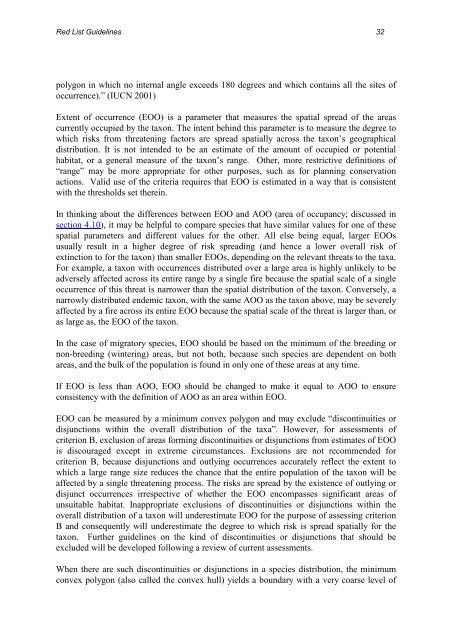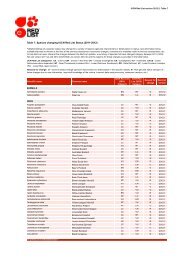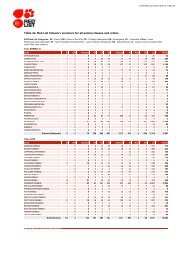IUCN Red List Guidelines - The IUCN Red List of Threatened Species
IUCN Red List Guidelines - The IUCN Red List of Threatened Species
IUCN Red List Guidelines - The IUCN Red List of Threatened Species
You also want an ePaper? Increase the reach of your titles
YUMPU automatically turns print PDFs into web optimized ePapers that Google loves.
<strong>Red</strong> <strong>List</strong> <strong>Guidelines</strong> 32<br />
polygon in which no internal angle exceeds 180 degrees and which contains all the sites <strong>of</strong><br />
occurrence).” (<strong>IUCN</strong> 2001)<br />
Extent <strong>of</strong> occurrence (EOO) is a parameter that measures the spatial spread <strong>of</strong> the areas<br />
currently occupied by the taxon. <strong>The</strong> intent behind this parameter is to measure the degree to<br />
which risks from threatening factors are spread spatially across the taxon’s geographical<br />
distribution. It is not intended to be an estimate <strong>of</strong> the amount <strong>of</strong> occupied or potential<br />
habitat, or a general measure <strong>of</strong> the taxon’s range. Other, more restrictive definitions <strong>of</strong><br />
“range” may be more appropriate for other purposes, such as for planning conservation<br />
actions. Valid use <strong>of</strong> the criteria requires that EOO is estimated in a way that is consistent<br />
with the thresholds set therein.<br />
In thinking about the differences between EOO and AOO (area <strong>of</strong> occupancy; discussed in<br />
section 4.10), it may be helpful to compare species that have similar values for one <strong>of</strong> these<br />
spatial parameters and different values for the other. All else being equal, larger EOOs<br />
usually result in a higher degree <strong>of</strong> risk spreading (and hence a lower overall risk <strong>of</strong><br />
extinction to for the taxon) than smaller EOOs, depending on the relevant threats to the taxa.<br />
For example, a taxon with occurrences distributed over a large area is highly unlikely to be<br />
adversely affected across its entire range by a single fire because the spatial scale <strong>of</strong> a single<br />
occurrence <strong>of</strong> this threat is narrower than the spatial distribution <strong>of</strong> the taxon. Conversely, a<br />
narrowly distributed endemic taxon, with the same AOO as the taxon above, may be severely<br />
affected by a fire across its entire EOO because the spatial scale <strong>of</strong> the threat is larger than, or<br />
as large as, the EOO <strong>of</strong> the taxon.<br />
In the case <strong>of</strong> migratory species, EOO should be based on the minimum <strong>of</strong> the breeding or<br />
non-breeding (wintering) areas, but not both, because such species are dependent on both<br />
areas, and the bulk <strong>of</strong> the population is found in only one <strong>of</strong> these areas at any time.<br />
If EOO is less than AOO, EOO should be changed to make it equal to AOO to ensure<br />
consistency with the definition <strong>of</strong> AOO as an area within EOO.<br />
EOO can be measured by a minimum convex polygon and may exclude “discontinuities or<br />
disjunctions within the overall distribution <strong>of</strong> the taxa”. However, for assessments <strong>of</strong><br />
criterion B, exclusion <strong>of</strong> areas forming discontinuities or disjunctions from estimates <strong>of</strong> EOO<br />
is discouraged except in extreme circumstances. Exclusions are not recommended for<br />
criterion B, because disjunctions and outlying occurrences accurately reflect the extent to<br />
which a large range size reduces the chance that the entire population <strong>of</strong> the taxon will be<br />
affected by a single threatening process. <strong>The</strong> risks are spread by the existence <strong>of</strong> outlying or<br />
disjunct occurrences irrespective <strong>of</strong> whether the EOO encompasses significant areas <strong>of</strong><br />
unsuitable habitat. Inappropriate exclusions <strong>of</strong> discontinuities or disjunctions within the<br />
overall distribution <strong>of</strong> a taxon will underestimate EOO for the purpose <strong>of</strong> assessing criterion<br />
B and consequently will underestimate the degree to which risk is spread spatially for the<br />
taxon. Further guidelines on the kind <strong>of</strong> discontinuities or disjunctions that should be<br />
excluded will be developed following a review <strong>of</strong> current assessments.<br />
When there are such discontinuities or disjunctions in a species distribution, the minimum<br />
convex polygon (also called the convex hull) yields a boundary with a very coarse level <strong>of</strong>






